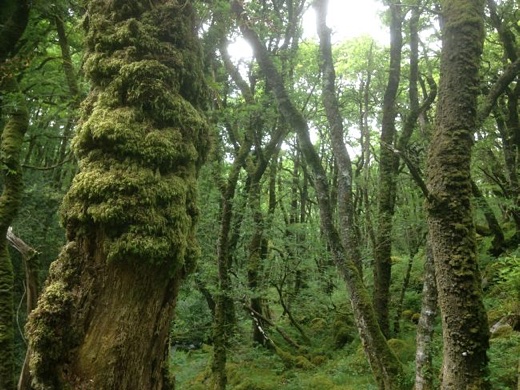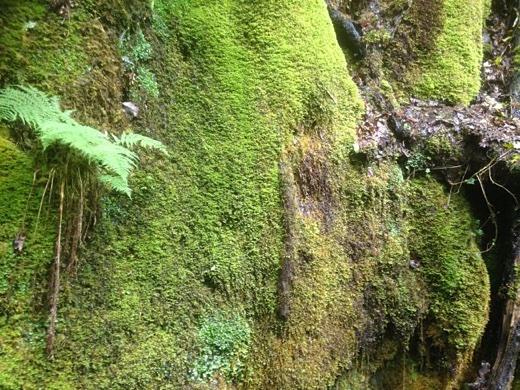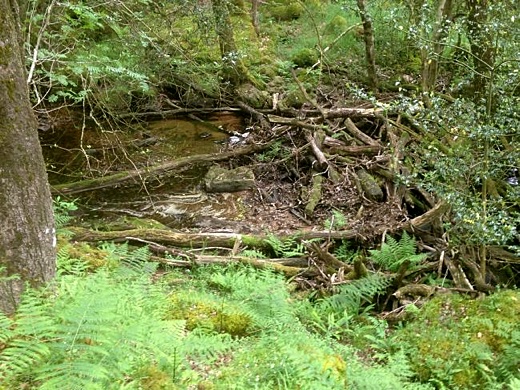SUBHEAD: The natural environment as a metaphor for how we organize our own human economies.
By Rob Hopkins on 20 June 2016 for Transition Network -
(https://www.transitionnetwork.org/blogs/rob-hopkins/2016-06/forest-economy-woodland-new-economy-metaphor)

Image above: Trees with leaves and moss moderate the movement of water over the landscape. From original article. See more photos in original article.
I spent Sunday afternoon having a beautiful walk in the woods with my son at Venton Brook, near Holne on Dartmoor, one of the most beautiful places on earth.
As we walked down through this ancient woodland, with its stream, its waterfalls, its trees, moss and lichen, the sun breaking through the canopy, I found myself thinking of this woodland not as an ecosystem, but as a metaphor for the kind of economy we are seeking to create in Transition.
As Bill Mollison wrote in 'Permaculture: a Designers' Manual', "trees are, for the earth, the ultimate translators and moderators of incoming energy". You can think of a forest as the most incredibly sophisticated water management system. Indeed, as you walk through a forest, all but 5-10% of what you're looking at is water.
When it rains over a wood like Venton Brook, the canopy intercepts it first. The leaves break the heavier droplets into a finer mist. Some of the water is held by the surface of the leaves, which are themselves small reservoirs of water, sometimes referred to as a "lake in the sky".
This interrupting of the power of the rain reduces the damage that heavy rain would otherwise do to bare soil.
The water that continues groundwards is no longer just water. It has picked up all manner of dust and other nutrients which it transfers to the soil. From the top of the trees to the bottom of their roots, woodlands have evolved many sophisticated ways of capturing water.
These include: Mosses on trees that act as sponges, able to hold a lot of water all the way up the trees, and crevasses on the trees, fissures in the bark and other plants growing on trees who also capture water:

Image above: Rockface covered in moss, lichen and ferns hold water. From original article.
Mosses and lichens on the rocks, such as those on the rockface near a waterfall which were holding a huge amount of water. This rockface held so much more water than bare rock would.
Dead wood, rather than being removed to keep the wood 'tidy', acts as an incubator for new life and, increasingly as it decomposes, as a sponge. Great thick mats of moss and decomposing wood are scattered across the ground, acting as a nursery to all manner of plants:
The leaf litter and deep rich soil that has formed beneath is also a key store of water. Soils with high organic matter are able to capture and hold high levels of water (1 cm of water for every 3cm of depth).
That top 60cm of soil contains 85% of the roots and 94% of the soil water. That fine mat of tree roots is then able to take what is now the perfect 'tree tea' and feed it back into the tree and back up to the leaves, as well as to slow its percolation into the soil. As Mollison puts it, "the forests represent great lakes of actively managed and actively recycled water".
And then of course there are the mycorrhizal fungi, those vast networks which store water while acting as the forest's brain, distributing resources and managing its response to disturbance.
Forests such as this have evolved as incredibly sophisticated, self-organising systems for holding and storing water and nutrients. It's why they are such a vital strategy in preventing the kind of flooding seen in the UK and elsewhere in recent years. Rather than surges of water, they act as a vast sponge, moderating the throughflow of water.
Even the brook itself seemed to have decided to get as much out of the water passing through it as possible: wide shallow sections full of water weeds, and piles of branches washed down in storms which collect at bottlenecks and which then, over time, become home to a range of plants.

Image above: Stream with decaying branch and ferns. From original article.
As we walked through the woods, I was thinking about what a perfect metaphor this place was for the kind of economy we strive to create in Transition initiatives. An economy based on maximising the Multiplier Effect. In this kind of economy, we become more skilful at capturing money that would otherwise just pass through our economy.
Then, once it is there, we strive get it to circulate as many times as possible, to pass from hand to hand to hand, incubating a great diversity of enterprises and businesses.
The alternative, the globalised neo-liberal economy, is the mirror opposite of our forest economy.
Rather than trying to maximise the number of places money can pass through or be stored, distributing it as much as possible, it aims to centralise, to concentrate that water into a handful of places.
The equivalent that I could think of would be to put plastic guttering around all our trees, dig channels to concentrate the water, so that as soon as a raindrop landed it was being channelled towards one of several large reservoirs. Not quite the same experience at all.
Nowhere in that wood could I see any one single species sucking up all that water to the detriment of others. Everything in the ecosystem acted as a good neighbour, stronger due to the diversity of what's around it. Nothing was wasted. It's a resilient system. In the event of a drought, a lack of input of water, it would survive so much longer than a monocultural field of crops or our more 'tidy' gardens.
If we can protect local economies from the predations of large extractive corporations, keep the metaphorical plastic guttering at bay, they will naturally move towards the kind of self-organising, diverse resilient systems that our woodland was modelling. It's a system designed to maximise the wellbeing of its community, through an approach based not on austerity but on being regenerative.
It's an economy that isn't about locking resources up, but allowing them to flow at different speeds, to allow some throughput, but to strive to ensure the maximum amount of circulation as possible. It's the thinking that underpins local currencies, although it can happen without them.
Mollison once also famously described tidiness as "maintained disorder". Extracting money from local economies requires highly efficient systems that have none of the disorder of natural systems.
Think of the difference between supermarket aisles and a marketplace with its diversity of eclectic stalls. Or the clone produce of the supermarket veg section, bereft of wonky carrots and nobbly potatoes as opposed to what appears in your CSA vegetable box.
As you walk through the woodland, what initially appears to be a messy riot of untidy chaos is in fact a highly sophisticated, vibrant, thriving ecosystem. It works. As do resilient local economies. And they're beautiful. As Mollison once said, "if we lose the Universities we lose nothing: if we lose the forests we lose everything". Amen to that.
.
By Rob Hopkins on 20 June 2016 for Transition Network -
(https://www.transitionnetwork.org/blogs/rob-hopkins/2016-06/forest-economy-woodland-new-economy-metaphor)

Image above: Trees with leaves and moss moderate the movement of water over the landscape. From original article. See more photos in original article.
I spent Sunday afternoon having a beautiful walk in the woods with my son at Venton Brook, near Holne on Dartmoor, one of the most beautiful places on earth.
As we walked down through this ancient woodland, with its stream, its waterfalls, its trees, moss and lichen, the sun breaking through the canopy, I found myself thinking of this woodland not as an ecosystem, but as a metaphor for the kind of economy we are seeking to create in Transition.
As Bill Mollison wrote in 'Permaculture: a Designers' Manual', "trees are, for the earth, the ultimate translators and moderators of incoming energy". You can think of a forest as the most incredibly sophisticated water management system. Indeed, as you walk through a forest, all but 5-10% of what you're looking at is water.
When it rains over a wood like Venton Brook, the canopy intercepts it first. The leaves break the heavier droplets into a finer mist. Some of the water is held by the surface of the leaves, which are themselves small reservoirs of water, sometimes referred to as a "lake in the sky".
This interrupting of the power of the rain reduces the damage that heavy rain would otherwise do to bare soil.
The water that continues groundwards is no longer just water. It has picked up all manner of dust and other nutrients which it transfers to the soil. From the top of the trees to the bottom of their roots, woodlands have evolved many sophisticated ways of capturing water.
These include: Mosses on trees that act as sponges, able to hold a lot of water all the way up the trees, and crevasses on the trees, fissures in the bark and other plants growing on trees who also capture water:

Image above: Rockface covered in moss, lichen and ferns hold water. From original article.
Mosses and lichens on the rocks, such as those on the rockface near a waterfall which were holding a huge amount of water. This rockface held so much more water than bare rock would.
Dead wood, rather than being removed to keep the wood 'tidy', acts as an incubator for new life and, increasingly as it decomposes, as a sponge. Great thick mats of moss and decomposing wood are scattered across the ground, acting as a nursery to all manner of plants:
The leaf litter and deep rich soil that has formed beneath is also a key store of water. Soils with high organic matter are able to capture and hold high levels of water (1 cm of water for every 3cm of depth).
That top 60cm of soil contains 85% of the roots and 94% of the soil water. That fine mat of tree roots is then able to take what is now the perfect 'tree tea' and feed it back into the tree and back up to the leaves, as well as to slow its percolation into the soil. As Mollison puts it, "the forests represent great lakes of actively managed and actively recycled water".
And then of course there are the mycorrhizal fungi, those vast networks which store water while acting as the forest's brain, distributing resources and managing its response to disturbance.
Forests such as this have evolved as incredibly sophisticated, self-organising systems for holding and storing water and nutrients. It's why they are such a vital strategy in preventing the kind of flooding seen in the UK and elsewhere in recent years. Rather than surges of water, they act as a vast sponge, moderating the throughflow of water.
Even the brook itself seemed to have decided to get as much out of the water passing through it as possible: wide shallow sections full of water weeds, and piles of branches washed down in storms which collect at bottlenecks and which then, over time, become home to a range of plants.

Image above: Stream with decaying branch and ferns. From original article.
As we walked through the woods, I was thinking about what a perfect metaphor this place was for the kind of economy we strive to create in Transition initiatives. An economy based on maximising the Multiplier Effect. In this kind of economy, we become more skilful at capturing money that would otherwise just pass through our economy.
Then, once it is there, we strive get it to circulate as many times as possible, to pass from hand to hand to hand, incubating a great diversity of enterprises and businesses.
The alternative, the globalised neo-liberal economy, is the mirror opposite of our forest economy.
Rather than trying to maximise the number of places money can pass through or be stored, distributing it as much as possible, it aims to centralise, to concentrate that water into a handful of places.
The equivalent that I could think of would be to put plastic guttering around all our trees, dig channels to concentrate the water, so that as soon as a raindrop landed it was being channelled towards one of several large reservoirs. Not quite the same experience at all.
Nowhere in that wood could I see any one single species sucking up all that water to the detriment of others. Everything in the ecosystem acted as a good neighbour, stronger due to the diversity of what's around it. Nothing was wasted. It's a resilient system. In the event of a drought, a lack of input of water, it would survive so much longer than a monocultural field of crops or our more 'tidy' gardens.
If we can protect local economies from the predations of large extractive corporations, keep the metaphorical plastic guttering at bay, they will naturally move towards the kind of self-organising, diverse resilient systems that our woodland was modelling. It's a system designed to maximise the wellbeing of its community, through an approach based not on austerity but on being regenerative.
It's an economy that isn't about locking resources up, but allowing them to flow at different speeds, to allow some throughput, but to strive to ensure the maximum amount of circulation as possible. It's the thinking that underpins local currencies, although it can happen without them.
Mollison once also famously described tidiness as "maintained disorder". Extracting money from local economies requires highly efficient systems that have none of the disorder of natural systems.
Think of the difference between supermarket aisles and a marketplace with its diversity of eclectic stalls. Or the clone produce of the supermarket veg section, bereft of wonky carrots and nobbly potatoes as opposed to what appears in your CSA vegetable box.
As you walk through the woodland, what initially appears to be a messy riot of untidy chaos is in fact a highly sophisticated, vibrant, thriving ecosystem. It works. As do resilient local economies. And they're beautiful. As Mollison once said, "if we lose the Universities we lose nothing: if we lose the forests we lose everything". Amen to that.
.
No comments :
Post a Comment